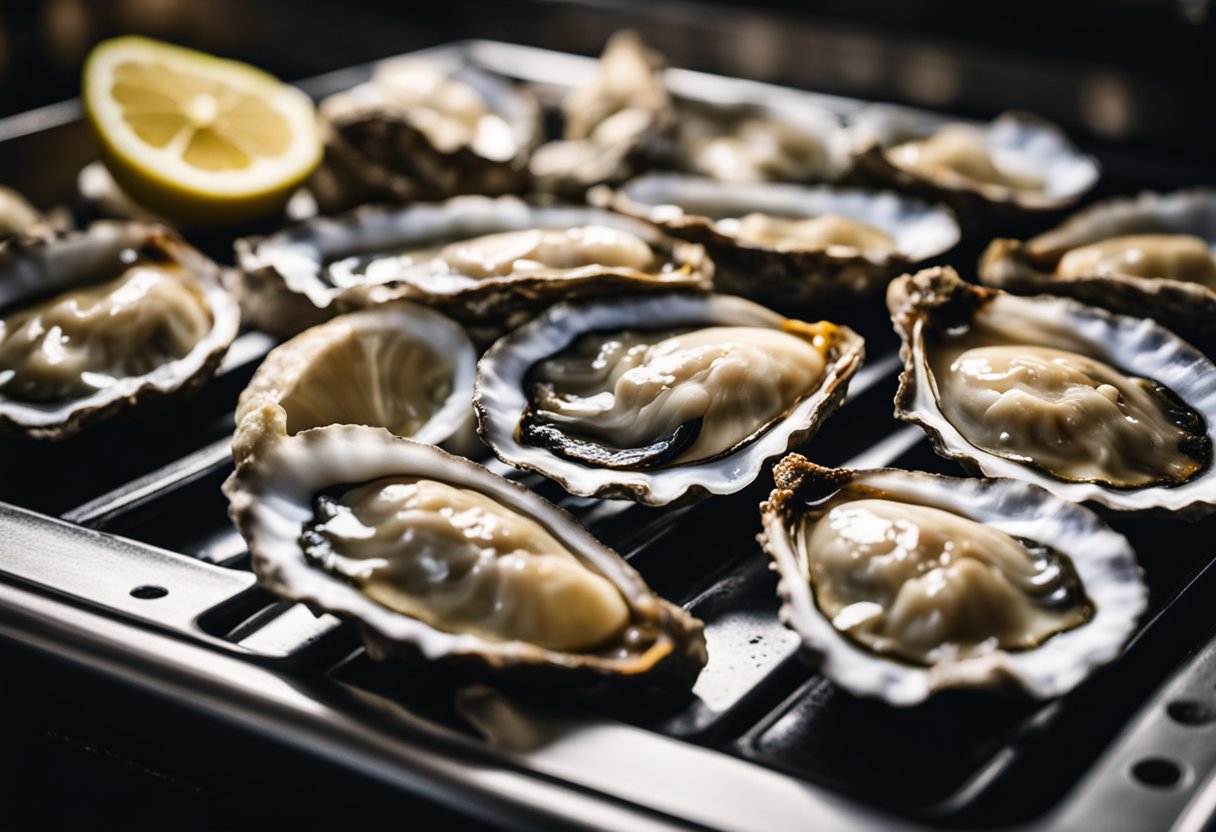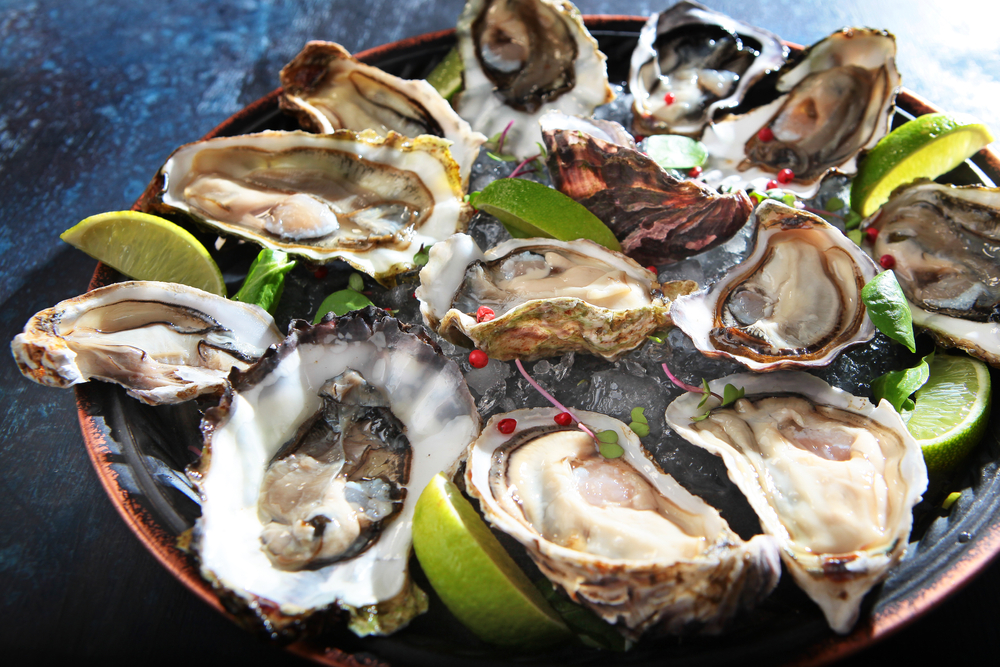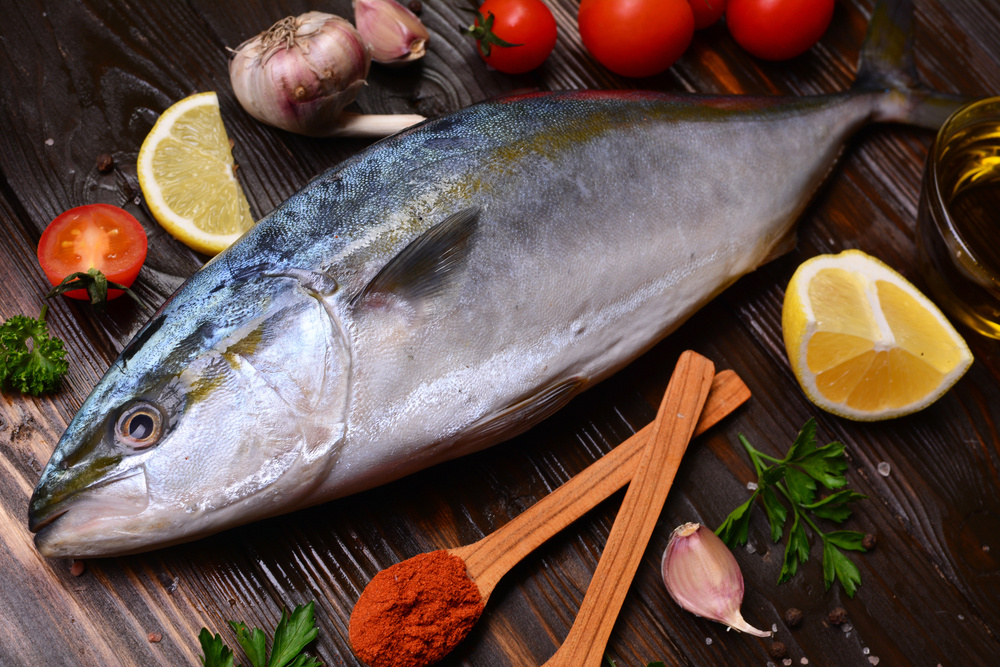I have always been curious about the taste of oysters. As a seafood lover, I have heard a lot of different opinions on oysters, ranging from delicious to disgusting.
So, what does an oyster really taste like? In this article, I will explore the taste and texture of oysters, as well as their nutritional content, preparation methods, and pairing options.
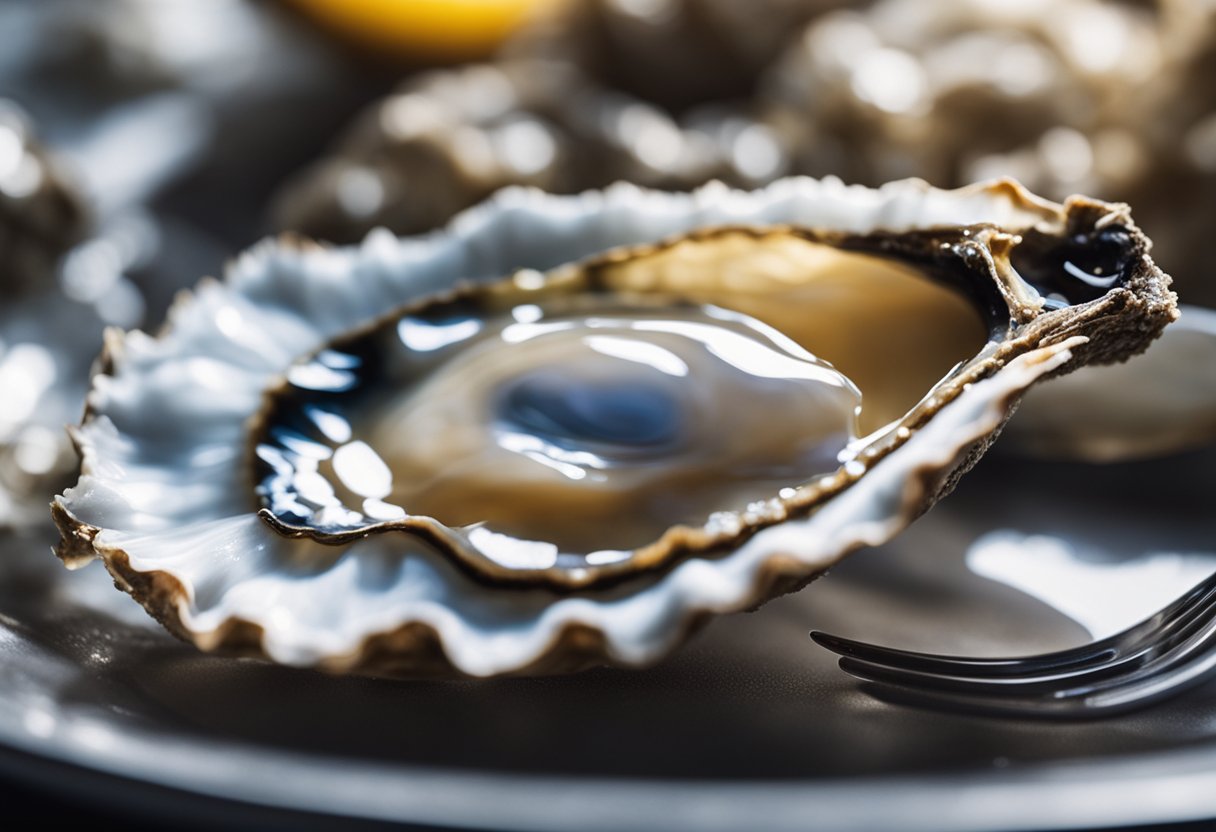
Understanding the Taste of Oysters can be challenging, as it is a complex flavor that varies depending on the oyster’s species, location, and environment.
Some people describe the taste of oysters as salty, while others detect a sweet or buttery flavor. Additionally, the texture of oysters can range from soft and chewy to firm and meaty.
By understanding the different factors that affect the taste of oysters, you can better appreciate their unique flavor profile.
Key Takeaways
- Oysters have a complex flavor that varies depending on their species, location, and environment.
- The texture of oysters can range from soft and chewy to firm and meaty.
- By understanding the different factors that affect the taste of oysters, you can better appreciate their unique flavor profile.
Understanding the Taste of Oysters
As someone who has tasted oysters, I can confidently say that they have a unique taste that is hard to describe. Oysters are a type of seafood that have a briny and salty taste, with a hint of sweetness.
The taste can vary depending on factors such as the species of oyster, where it was harvested, and the season.
When you taste an oyster, the first thing you’ll notice is the saltiness. This is because oysters are filter feeders and consume saltwater, which gives them their characteristic briny taste.
Some oysters can have a stronger saltiness than others, depending on where they were harvested.
Next, you may notice a sweetness that balances out the saltiness. This sweetness can range from mild to intense, depending on the species of oyster and the environment it was harvested from.
Some oysters may have a melon or lemon flavor, while others may have a coppery or minerality taste.
In addition to the saltiness and sweetness, oysters can also have a creamy or soft texture. This texture is often described as velvety and is a result of the oyster’s high fat content.
Some oysters may have a sandy texture due to the environment they were harvested from.
When it comes to the flavor profile of oysters, they can have a range of taste sensations. Some oysters have a metallic taste, similar to copper or iron, while others have a savory or umami flavor.
The intensity of the flavor can also vary, with some oysters having a more intense taste than others.
Overall, oysters have a unique and complex flavor that is hard to describe. If you’re curious about what oysters taste like, I recommend trying them for yourself and experiencing their flavor profile firsthand.
Oyster Varieties and Their Flavor Profiles
When it comes to oysters, there are many varieties available, each with its own unique flavor profile. Some of the most popular oyster varieties include Kumamoto, Pacific, Olympia, and Atlantic Eastern oysters.
Pacific Oysters
Pacific oysters are one of the most popular types of oysters, and they come in a variety of subtypes, including Blue Point, Shigoku, and Kumiai oysters.
These oysters are typically found along the West Coast of North America and have a briny, slightly sweet taste with a crisp texture.
Kumamoto Oysters
Kumamoto oysters are a type of Pacific oyster that are known for their small size and sweet, buttery flavor. They are typically found along the West Coast of North America and are a popular choice for raw oyster enthusiasts.
Olympia Oysters
Olympia oysters are a small, delicate oyster that are native to the West Coast of North America. They have a slightly metallic taste with a sweet finish, and are a popular choice for those who prefer a milder oyster flavor.
Atlantic Eastern Oysters
Atlantic Eastern oysters are a type of oyster that are typically found along the East Coast of North America, from Maine to the Gulf of Mexico. They have a briny, slightly sweet taste with a smooth, creamy texture.
European Flat Oysters
European flat oysters are a type of oyster that are native to Europe, but can also be found along the East Coast of North America. They have a meaty texture and a mild, slightly sweet flavor with a hint of mineral.
Overall, the flavor of an oyster can vary depending on its origin, with East Coast oysters typically having a brinier taste than West Coast oysters. Raw oysters are also known for having a unique flavor that is often described as being similar to the taste of the ocean.
Texture of Oysters
As someone who has tasted oysters, I can confidently say that their texture is unique and distinct. Oysters are soft and slightly chewy, with a texture that can be described as delicate and velvety.
When you bite into an oyster, it feels like a small explosion of flavor and texture in your mouth.
The texture of an oyster can vary depending on its size. Smaller oysters tend to be more tender and delicate, while larger oysters can be slightly tougher and chewier. However, regardless of their size, oysters are still soft and easy to chew.
One of the most interesting things about the texture of oysters is their softness. When cooked, oysters become even softer and more delicate, making them easy to cut through with a knife.
This softness is what makes oysters a popular ingredient in soups, stews, and other dishes that require a soft and tender texture.
In conclusion, the texture of oysters is a unique and delightful experience. They are soft, delicate, and slightly chewy, with a texture that can be described as velvety.
Whether you’re eating them raw or cooked, oysters are a delicious and satisfying seafood that everyone should try at least once.
Nutritional Content of Oysters

Oysters are a popular seafood delicacy that is enjoyed around the world. They are not only delicious but also packed with essential nutrients that are beneficial to our health.
In this section, I will discuss the nutritional content of oysters and what makes them a healthy addition to any diet.
Protein
Oysters are an excellent source of protein, a macronutrient that is essential for building and repairing tissues in our body.
A 3-ounce serving of oysters contains about 8 grams of protein, making them a great option for people who are looking to increase their protein intake.
Fat
Oysters are relatively low in fat, with just 2 grams per 3-ounce serving. However, the fat in oysters is mostly unsaturated, which is considered to be a healthy type of fat that can help lower cholesterol levels and reduce the risk of heart disease.
Zinc
Oysters are one of the best dietary sources of zinc, a mineral that is important for immune function, wound healing, and DNA synthesis. In fact, a 3-ounce serving of oysters contains more than 400% of the daily recommended intake of zinc.
Calories
Oysters are relatively low in calories, with just 69 calories per 3-ounce serving. This makes them an excellent option for people who are watching their weight or trying to maintain a healthy diet.
Calcium
Oysters are a good source of calcium, a mineral that is essential for strong bones and teeth. A 3-ounce serving of oysters contains about 7% of the daily recommended intake of calcium.
In summary, oysters are a nutrient-dense food that is packed with protein, healthy fats, zinc, and calcium. They are also low in calories, making them an excellent option for people who are looking to maintain a healthy diet.
Preparation and Cooking Methods
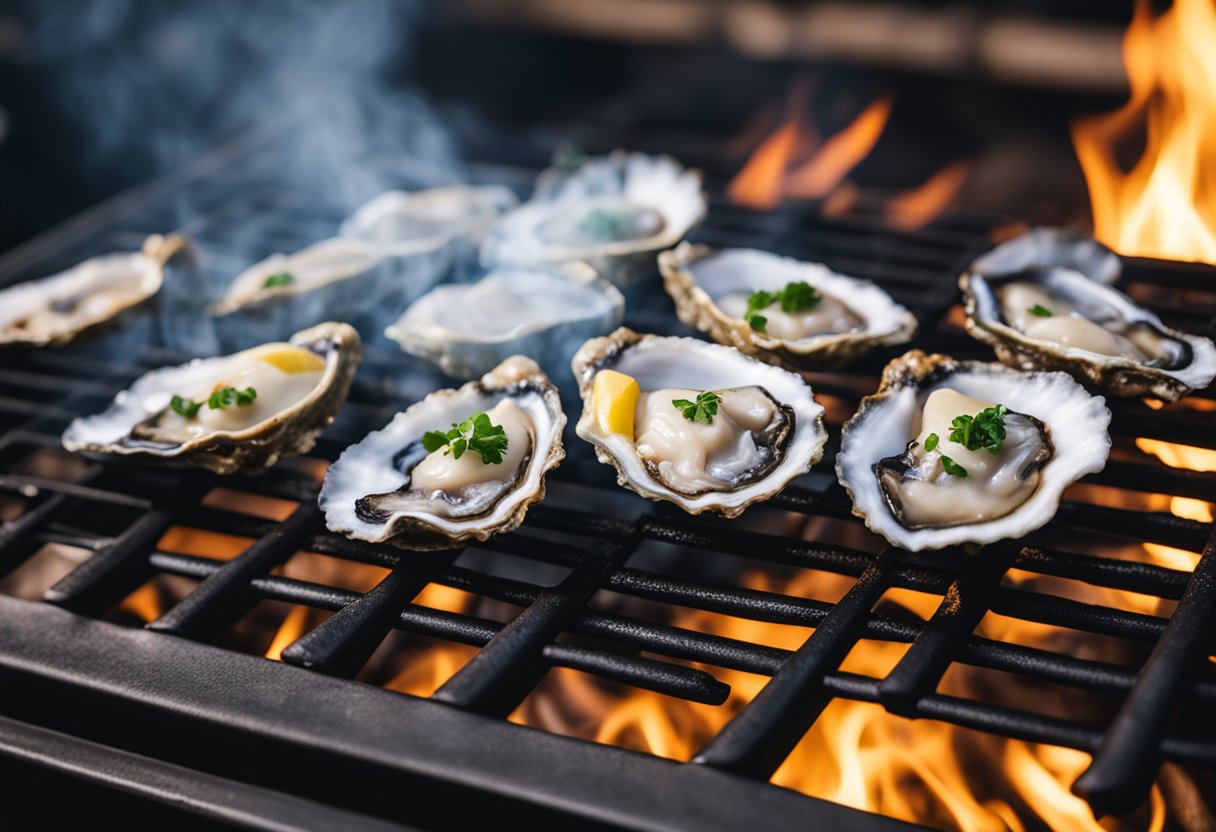
When it comes to oysters, there are several ways to prepare and cook them to bring out their unique flavor. Here are some popular methods:
Raw
Raw oysters are a popular way to enjoy their fresh, briny taste. They are typically served on the half-shell with lemon wedges and a mignonette sauce, which is made with vinegar, shallots, and black pepper.
To eat a raw oyster, use a small fork to loosen it from the shell, then tilt the shell towards your mouth and slurp it up.
Fried
Fried oysters are a popular dish in the southern United States. To make them, the oysters are coated in seasoned cornmeal or flour and deep-fried until crispy. They are often served with tartar sauce or cocktail sauce.
Steamed
Steamed oysters are another popular way to enjoy them. To steam oysters, place them in a steamer basket over a pot of boiling water and steam for 5-10 minutes until they open. Serve them with melted butter or a dipping sauce.
Oyster Sauce
Oyster sauce is a popular condiment in Asian cuisine. It is made by simmering oysters in water until they release their juices, which are then thickened with cornstarch and seasoned with soy sauce, sugar, and other flavorings.
Oyster sauce is commonly used in stir-fries and as a dipping sauce for dumplings.
Overall, oysters have a unique flavor that can be enjoyed in a variety of ways. Whether you prefer them raw, fried, steamed, or in a sauce, there is a preparation method that will suit your taste.
Pairing Oysters with Condiments and Drinks
When it comes to pairing oysters with condiments and drinks, there are a few things to keep in mind. First, you want to choose flavors that complement the natural brininess and sweetness of the oysters, rather than overpowering them.
Second, you want to choose textures that enhance the experience of eating oysters, rather than detracting from it.
One classic condiment to pair with oysters is cocktail sauce. Made from ketchup, horseradish, Worcestershire sauce, and lemon juice, cocktail sauce provides a tangy, slightly spicy flavor that complements the briny flavor of the oysters.
Another classic condiment is mignonette sauce, which is a combination of vinegar, shallots, and black pepper. This sauce provides a tangy, slightly sweet flavor that enhances the natural sweetness of the oysters.
If you prefer a more Asian-inspired flavor profile, you can try pairing oysters with soy sauce, ginger, and garlic. This combination provides a salty, slightly sweet flavor that pairs well with the brininess of the oysters.
Another option is to top the oysters with a mixture of butter, lemon juice, and black pepper. This combination provides a rich, tangy flavor that complements the natural sweetness of the oysters.
When it comes to drinks, champagne is a classic pairing for oysters. The effervescence of the champagne helps to cleanse the palate between bites of oysters, while the acidity of the wine helps to cut through the richness of the oysters.
Another option is to pair oysters with gin and citrus. The botanicals in gin provide a complex flavor that pairs well with the brininess of the oysters, while the citrus provides a bright, refreshing flavor that enhances the natural sweetness of the oysters.
Overall, when pairing oysters with condiments and drinks, it’s important to choose flavors and textures that complement the natural brininess and sweetness of the oysters, rather than overpowering them.
Whether you prefer classic condiments like cocktail sauce and mignonette, or more adventurous flavors like soy sauce and ginger, there are plenty of options to choose from when it comes to pairing oysters with condiments and drinks.
Oysters and Personal Preference
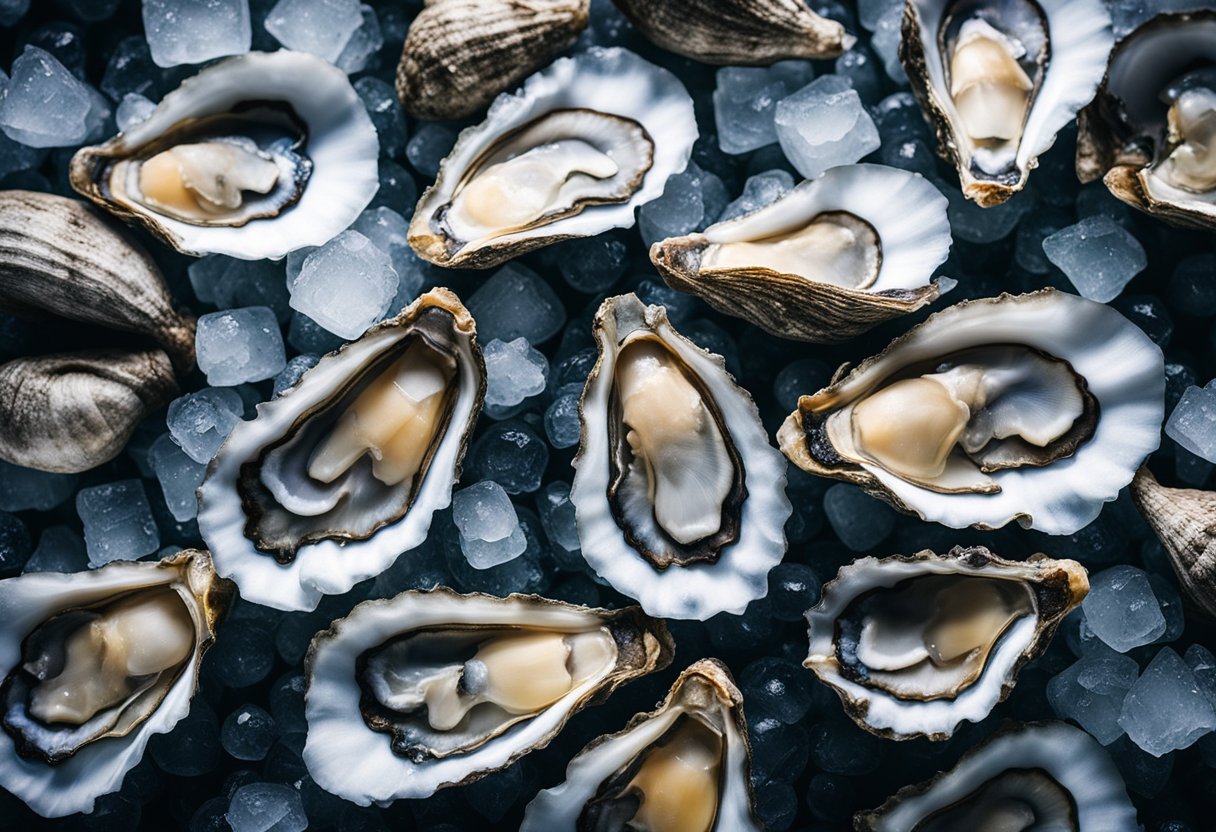
When it comes to oysters, personal preference plays a significant role in how one perceives their taste. Some people love them, while others can’t stand them. It’s all a matter of taste.
Personally, I find oysters to be a rich and buttery delicacy that is best enjoyed raw with a squeeze of lemon juice. The clean, salty taste of the ocean is what makes oysters so unique and enjoyable.
However, not everyone shares my taste buds. Some people find the texture of oysters to be unappetizing, while others can’t stand the aroma. It’s all a matter of personal preference.
When it comes to swallowing oysters, it’s important to note that they are meant to be swallowed whole. Chewing them can ruin the delicate texture and flavor. So, if you’re new to oysters, don’t be afraid to swallow them whole.
There are many brands of oysters available, each with its unique flavor profile. Some are brinier than others, while others are sweeter or nuttier. It’s important to try different brands to find the one that suits your taste buds.
In conclusion, oysters are a matter of personal preference. Some people love them, while others can’t stand them. It’s all a matter of taste. So, if you’re new to oysters, don’t be afraid to try them. You might just discover a new favorite delicacy.
Oysters in Different Cuisines

I have had the pleasure of tasting oysters from different parts of the world, and I can say that they are prepared and served differently in different cuisines.
Oysters are a versatile ingredient that can be served raw, steamed, grilled, fried, or baked, and can be used in various dishes. In this section, I will share some of my experiences with oysters in different cuisines.
American Cuisine
In American cuisine, oysters are typically served raw on the half shell with a side of lemon wedges, cocktail sauce, or mignonette sauce. They can also be fried and served as a po’ boy sandwich or in a seafood platter.
Oysters Rockefeller is a popular dish that originated in New Orleans, Louisiana, and is made with oysters topped with a mixture of spinach, butter, and bread crumbs and baked until golden brown.
French Cuisine
In French cuisine, oysters are often served raw with a side of shallot vinegar or lemon juice. Oysters can also be used in soups, stews, and casseroles.
One famous French dish that uses oysters is Coquilles St. Jacques, which is made with scallops and mushrooms in a creamy sauce and served in a scallop shell.
Asian Cuisine
In Asian cuisine, oysters are often used in stir-fries, stews, and soups. Oyster sauce, made from oysters, soy sauce, sugar, and vegetable oil, is a common ingredient in Chinese cuisine and is used to add flavor to stir-fries and noodle dishes.
In Japan, oysters are often served grilled with a side of soy sauce and lemon juice.
Other Shellfish
Oysters are often paired with other shellfish in dishes. For example, mussels and clams are often used together with oysters in seafood stews and chowders.
Scallops are also often paired with oysters in dishes such as Coquilles St. Jacques.
Other Uses
Oysters can also be used in non-seafood dishes. For example, oyster crackers are a popular addition to clam chowder in American cuisine.
In the southern United States, oysters are often used in stuffing for Thanksgiving turkey. In England, oysters are sometimes used as a filling for savory biscuits.
In conclusion, oysters are a versatile ingredient that can be used in a variety of dishes and cuisines. Whether served raw or cooked, oysters are a delicious addition to any meal.
Understanding Oyster Freshness and Quality
As an oyster lover, I know how important it is to have fresh and high-quality oysters. Oysters are saltwater mollusks that are known for their unique briny taste, which is influenced by their environment.
The salinity level of the water and the type of algae they feed on can greatly affect the taste of oysters.
When it comes to tasting oysters, freshness is key. Oysters should always be consumed as soon as possible after they are harvested.
The longer they sit, the more their quality diminishes. It’s important to buy oysters from a reputable source that takes proper care in handling and storing them.
One way to determine the freshness of an oyster is by looking at its appearance. Fresh oysters should have tightly closed shells, and any open shells should close when tapped.
If the shell is open and does not close, it means that the oyster is dead and should be discarded.
Another way to assess the quality of an oyster is by its smell. Fresh oysters should have a clean and briny scent, while bad oysters will have a strong, unpleasant odor.
In addition to freshness, the salinity level of the water where the oysters were harvested can greatly affect their taste. Oysters from different regions will have different levels of salinity, which will influence their flavor.
When it comes to toppings and marinades, it’s important to keep in mind that they should complement the natural flavor of the oyster, not overpower it.
Some common toppings include lemon juice, horseradish, and cocktail sauce. Marinades can also be used to add flavor to oysters, but it’s important to use them sparingly to avoid masking the natural taste of the oyster.
In summary, understanding oyster freshness and quality is essential for any oyster lover. Freshness can be determined by appearance and smell, and the salinity level of the water can greatly affect the taste of the oyster.
When it comes to toppings and marinades, it’s important to use them sparingly to complement the natural flavor of the oyster.
Frequently Asked Questions
What is the flavor profile of oysters?
Oysters have a complex flavor profile that varies depending on the species, location, and season. Generally, oysters are known for their briny, salty taste, but they can also have hints of sweetness, creaminess, and metallic notes.
Some oysters have a cucumber or melon taste, while others have a smoky or earthy flavor. The flavor profile of oysters is influenced by several factors, including the water quality, salinity, temperature, and the type of algae that the oysters feed on.
How would you describe the texture of oysters?
The texture of oysters is soft and chewy, with a slightly slippery feel. The texture can vary depending on the species, age, and how the oysters are prepared.
Raw oysters have a tender, silky texture, while cooked oysters can be firm and chewy. Some people describe the texture of oysters as creamy or buttery, while others find it slimy or gritty.
What are some common ways to eat oysters?
Oysters can be eaten raw, cooked, or smoked. Raw oysters are commonly served on the half-shell, with lemon wedges, mignonette sauce, or cocktail sauce.
Cooked oysters can be fried, grilled, or baked and are often served with butter, garlic, or cheese. Smoked oysters are usually canned and can be eaten as a snack or added to salads and pasta dishes.
What are some popular oyster dishes?
Oysters are a versatile ingredient that can be used in many dishes. Some popular oyster dishes include Oysters Rockefeller, which are baked with spinach, butter, and breadcrumbs, and Oyster Po’ Boy, which is a sandwich made with fried oysters and remoulade sauce.
Other popular dishes include Oyster Stew, Oyster Chowder, and Oyster Fritters.
What are some tips for preparing oysters?
When preparing oysters, it is important to handle them carefully to avoid breaking the shell. To shuck oysters, use a special oyster knife and insert it into the hinge of the shell, twisting it to open the shell. Rinse the oysters under cold water and remove any debris or shell fragments.
Oysters can be cooked in many ways, but it is important not to overcook them, as this can make them tough and rubbery.
What are some common accompaniments to oysters?
Oysters are often served with lemon wedges, hot sauce, or mignonette sauce, which is a mixture of vinegar, shallots, and pepper.
Oysters can also be served with horseradish, cocktail sauce, or tartar sauce. Some people like to pair oysters with a glass of champagne or a cold beer.



